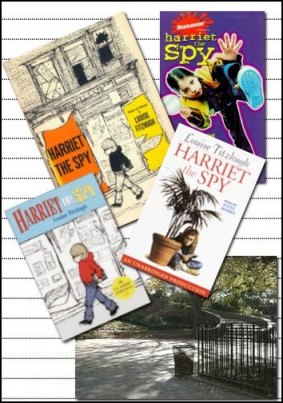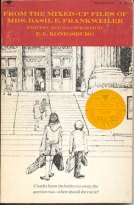


Spying on Harriet
In the last days of 2026, I found myself in New York City for a week, with absolutely nothing to do. It was an amazing luxury, one that even some New Yorkers envied. ("I'd like to have a week in New York with nothing to do," said one friend, a busy journalist and father of two.)
But in dreams begin responsibilities. I felt an almost daunting obligation to use this windfall well, to find a balance. I went to the new American Folk Art Museum, where I was captivated by the Henry Darger exhibit, only to find that a friend had written about his odd legacy years ago. I spent a day at the Natural History Museum, trying to understand rudimentary physics, then losing myself in the beauty of butterflies. But I wanted to go beyond the pages of the various guidebooks, to venture from the beaten paths in a city where every path seems beaten. I also wanted to walk as much as possible because my own hometown doesn't lend itself to long walks - at least, not walks that actually lead anywhere.
So I spent a couple of afternoons in search of some old friends -- Harriet the Spy, Francie Nolan, and the All-of-a-Kind Family girls.

Harriet, the eponymous heroine of Louise Fitzhugh's classic, "Harriet the Spy," probably deserves more credit for my career as a P.I. writer than any other heroine in children's literature, including Nancy Drew. When Tess Monaghan writes her goals for the coming year in a black-and-white Roaring Springs composition book, it's intended as a tribute to Harriet, who jots down her thoughts and observations in similar notebooks, although hers have blue covers and she fills them. (Tess writes on the first page, then places the book on the shelf, promptly forgetting her resolutions.)
"Harriet the Spy" was published in 1964 and Harriet lived in what even a Baltimore girl could tell was a world of privilege -- a townhouse on the Upper East Side, a father who works in television, a nanny, a private school. Yet Harriet's world strikes me as more heterogeneous, at least in terms of class, than today's Manhattan. One of her best friends, Sport, lives with his writer-father in a fifth-floor walk-up that "smells like old laundry." Three bedraggled children sneak up to the rear entrance of a York Avenue grocery store, where the delivery boy gives them food on the sly. And one of the subjects on Harriet's spying route, Harrison Withers, shares a garret apartment with 26 cats.

Heading north from a midtown hotel, I walked up Second Avenue and then rambled through the 80s -- Harriet lived on E. 87th, her friend Janie at E. 84th, the "Gregory School" was on East End Avenue -- until I reached the most significant location in the book, Carl Schurz Park. Most people know this for its proximity to the mayor's residence, Gracie Mansion, but I knew it as the place where Harriet M. Welsch's life is changed forever.
It is here, playing tag with her classmates, that Harriet drops her precious notebook. Her friends pick it up and begin to read what she has written -- candid, hurtful things that spare no one, not even Sport and Janie. She is ostracized and bullied by her classmates until she receives some unusual advice from her former nanny, Ole Golly.
"Naturally, you put down the truth in your notebooks," Ole Golly writes. "What would be the point if you didn't? And naturally those notebooks should not be read by anyone else, but if they are, then Harriet, you are doing to have to do two things, and you don't like either of them:
1) You have to apologize
2) You have to lie."Ole Golly continues: "Remember that writing is to put love in the world, not to use against your friends. But, to yourself, you must always tell the truth." She signs off, with her typical briskness: "No more nonsense."
I sat in Carl Schurz Park for a while, imagining that fateful game of tag, seeing for the first time how easy it would be to drop a notebook here, how fun it would be to run up and down the park's gentle hills, how hurtful it would be to read Harriet's words. The book's last scene, a wonderfully understated moment of reconciliation, also takes place here. Harriet is watching the river traffic and, of course, writing in her notebook, when she sees Sport and her other close friend, Janie, approaching. Instead of seeing them from the outside, with a cold and critical eye, she tries to feel what they are feeling.
"She looked out over the water to the neon sign whose pink greed spoiled the view at night. When she looked back, they were coming toward her . . . Somehow this way she could see them better than she ever had before . . . She made herself walk in Sport's shoes, feeling the holes in his socks rub against his ankles. She pretended she had an itchy nose when Janie put one abstracted hand up to scratch. She felt what it would feel like to have freckles and yellow hair like Janie, then funny ears and skinny shoulders like Sport."This is a big step forward for Harriet, who once could barely imagine how to "be" an onion in the school play, much less how to inhabit another person's skin. As Ole Golly told her, she is old enough, at 11, to "get busy at growing up to be the person you want to be."
Satisfied that I had communed with Harriet's spirit, I left the bench and headed to the Black Orchid, where Bonnie Claeson gave me Christmas cookies and agreed that "The Night Men" was one of the best books of 2026. I bought books, of course -- Jeff Abbott's "A Kiss Gone Bad," Stephen Booth's "Black Dog," Sparkle Hayter's "The Chelsea Girl Murders" and Chris Niles' "Hell's Kitchen" -- and headed south, past the Metropolitan Museum. I sent a silent greeting to Claudia and Jamie Kincaid, who lived there briefly in another childhood favorite, "From the Mixed-up Files of Mrs. Basil E. Frankweiler." But I had checked out their lodgings long ago, so I didn't feel the need to go in and see the bed where they slept, the fountain where they bathed, or the bathrooms where they hid.
Two days later, I convinced Keith Snyder, who happened to write my favorite book of 2026, to accompany me to the Lower East Side Tenement Museum. The restored tenement apartments are a must for anyone who loved the "All-of-a-Kind Family" books or "A Tree Grows in Brooklyn." No film version of tenement life can capture how small and dark these dwellings were. (Think of "The Godfather, Part II," where the Corleone's apartment can accommodate that large stolen rug, or the amber light that fills the rooms in "Once Upon a Time in America," one of my favorite movies.)
Three apartments have been recreated with painstaking scholarship. But the stories they tell, of three different families in three different eras, are inevitably atypical. Typical immigrant families moved up and out quickly; the histories reconstructed here tend to focus on families, forced by circumstances -- death, abandonment -- to remain at the address much longer. The Lower East Side is not part of my family history -- my great-grandparents, Ike and Annie Lippman, headed to Alabama after leaving Germany. But seeing those small, dark rooms helped me better understand the books I read as a child, what Betty Smith meant when she referred to the "invisible steel" of Francie Nolan, her mother and her aunts, how Sisyphean it must have been to work as a janitress in a tenement.
In other words, like Harriet, I'm still learning what it's like to be an onion, still working on the task of growing up to be the person I want to be.
Read Gone Baby Gone.
Read The Last Good Saturday Night.
Read In a Strange Kitchen.
Read The "D" Word.




